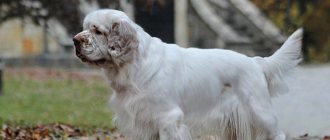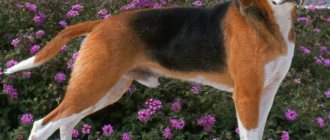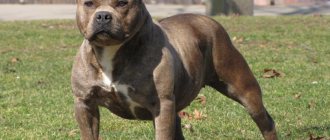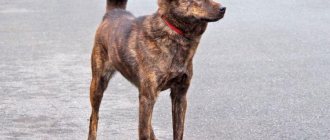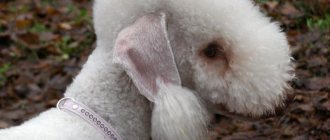Best known for its long, dreadlock-like coat, the Puli is a hard-working herding dog and family companion. An energetic and friendly dog originally from Hungary, his coat makes him appear much larger than he is.
- Country of origin : Hungary
- Height at withers : Female: 36–42 cm, male: 39–45 cm
- Weight : Female: 10–13 kg, male: 13–15 kg
- Lifespan : 12-16 years
- Use : companion dog, shepherd, watchdog, service dog
- Other names : Hungarian water dog, Hungarian Puli
History of the breed
The Puli is an ancient breed with a history dating back at least 2,000 years. Some believe that the bullet-like dog existed 6,000 years ago or more; others believe that the Puli originated more recently from the Tibetan Terrier.
There is evidence that the Sumerians used puli type dogs to herd sheep thousands of years ago. Clay tablets found during excavations at the city of Eridu reveal Sumerian animal laws. One of them contains lines that refer to the Puli and the Komondor, another herding dog. Also at the same excavation site, an intact bullet figurine was found in the crypt of an eight-year-old girl.
About 1,100 years ago, Magyar tribes brought the bullets to Hungary, where they became prized for their herding abilities. Many shepherds preferred black dogs because they were easier to see among the white flocks. It is believed that the Puli was used to herd and herd sheep, while the larger Komondor was used to guard the flocks.
In those days, a good puli cost as much as a full year's salary of a shepherd. However, as much as they valued their dogs, they ruthlessly selected those who were not as intelligent or could not perform their duties well. Many believe that this culling is the reason why the Puli is such an intelligent and healthy breed today.
In 1912, Dr. Emil Rajcic, a professor at the Hungarian University of Veterinary Medicine, began a program to save the bullet from extinction. He was joined by the director of the Budapest Zoo, Adolf Lendl. Together they reconstructed part of the zoo to house an experimental breeding program and exhibition. The program expanded and they eventually named their nursery Allatkert.
In 1915, enthusiasts wrote the first breed standard for the Puli. In 1924, the International Kennel Club approved this standard.
By this time, owning a Puli, Komondor or other native Hungarian breeds had become a source of pride in Hungary. The Second World War was devastating for Hungary and also for dog breeders, especially in Europe. There was not enough food, and there was no medicine at all. Nurseries had to give away their valuable breeding stock to people in other countries, and the remaining bullets were often killed by bombs or shot by German soldiers. If this breed had not been so popular before the war, it would probably be extinct now. In 1959, the Hungarian club created a standard for the Puli breed. By the 1960s, the number of Puliks in Hungary had reached pre-war numbers.
Puli: features of the breed
- Bullets are very loud and tend to bark.
- They do not shed and there is no need to comb dreadlocks.
- Bullets are stubborn, so training problems may arise. It is recommended to conduct training in a training area with other dogs.
- They remain puppies until they are very old. They love to play at any age, especially with their favorite toys.
- There is no undercoat. Puli has no undercoat, just puppy fluff. Many owners cut their pet's hair, but you need to understand that dreadlocks protect it from any weather. Without them, he is defenseless and only needs to be kept at home.
- Puli loves his family but is suspicious of strangers.
- Needs constant training. Even a perfectly trained dog can make a different decision at any time and act on its own.
Description
This is a medium-sized dog, males at the withers reach 45 cm, females 42 cm. Weight 13-15 kg.
This is one of the few breeds whose fur is collected in cords, reminiscent of dreadlocks. Cords begin to form at 9 months of age and some owners prefer to trim their dogs to avoid grooming.
These cords continue to grow throughout the dog's life and can reach the ground by age 5.
It is believed that bullets can only be black in color, since it is the most common.
However, other colors are also acceptable: white, gray, cream. Most dogs are a solid color, but cream dogs may have a black mask on their face.
The rest of the dog's features are hidden by the fur. Underneath is a muscular and athletic body with a well-proportioned head. The eyes are dark brown, the ears are v-shaped with rounded tips.
Care and maintenance
- Dreadlocks grow throughout your life. They don't shed and don't need to be brushed. It is necessary once a year to separate the dreadlocks with your fingers from roots to ends so that they do not get confused with each other.
- Wash no more than once every two months. After washing, dry thoroughly with a towel. An adult dog will be completely dry in 4 days.
- It is recommended to contact professional groomers.
- Clean your ears every three days.
- Clean your eyes as mucous discharge occurs.
- Dental care. It is enough to examine the teeth and oral cavity of the bullet once a week. As for the care itself, during a thorough examination you should pay attention to: The condition of the gums - if they are red and inflamed, it is recommended to contact a veterinarian who will recommend special medications or remedies;
- Teeth color – ideally, it should remain normal, without plaque (you can clean it yourself) and purulent formations. To maintain teeth in good condition, special bones and toothpastes for dogs can be very useful;
- Dental health – check for loose or broken teeth. Between them there should also be no food residues, the accumulation of which causes the animal to develop an unpleasant odor from the mouth and subsequently rot;
- The presence of tartar - in this case, it is impossible to do without the intervention of a veterinarian and its removal. It should also be noted that an important factor for the health of the bullet - and in particular the teeth - is proper balanced nutrition.
Remember that all dog grooming procedures help to establish a relationship with the dog and train him to be disciplined. Regular checking of the Puli puppy will develop into a kind of obligatory and pleasant communication procedure. If you notice any changes in behavior or find any unexplained sores or redness, contact your veterinarian.
Choosing a puppy
The national Hungarian dog Pumi is not widely used today, so it is not even possible to find reviews about it in the public domain. There are also few advertisements for the sale of puppies; prices start at $300. It is better to look for a pet for yourself in specialized nurseries and exhibitions, where you can evaluate not only the puppy, but also its parents and, importantly, their mental state.
The babies are very fluffy and look more like furballs than brave shepherds. It is unlikely that it will be possible to visually establish belonging to the breed (especially considering that there are many adjacent and very similar ones); confirmation of the origin and belonging specifically to the Pumi will only be a pedigree registered in the FCI system.
The purebred nature of puppies can only be proven by an official pedigree.
Health
Like any other breed of dog, Puli is prone to certain diseases:
- Hip dysplasia.
- Bloating.
- Skin diseases.
- Eye diseases.
Preventive measures to keep your puppy safe from bullets
- To keep your Puli puppy completely safe, you first need to minimize his contact with unfamiliar dogs, especially strays. Therefore, you should not let your dog off the leash, as in this case it will become impossible to control its behavior and communication with other dogs. Since a dog can easily become infected with distemper from simply touching the nose of a sick animal. This disease can be transmitted to a dog through sniffing. Your dog can become infected with trichophytosis from contact with the lichen-affected fur of a sick dog. Naturally, it is impossible to completely exclude a dog’s communication with other dogs, since it must be socialized. Therefore, try to find friends with dog lovers who look after their animals. By adhering to this rule, you can eliminate the risk of pathogen transmission by 80%.
- You should walk your dog in places where there are no landfills. Since garbage very often attracts rodents, which in turn are very often carriers of various infections. Gray rats are especially dangerous because they carry such a serious disease as leptospirosis.
- You should not allow your dog to sniff other people's feces, as they are a source of worms.
- Monitor the well-being of the bullet. Pay attention to even the most minor changes in his behavior. For example, your dog may appear lethargic, lose his appetite, or have a dry nose. Or you may notice that the dog begins to shed, and this has nothing to do with seasonal shedding. If hair loss becomes excessive, this is the first symptom indicating health problems in your pet. And only you can help him. Therefore, it is important to take the dog to the veterinary clinic in time, where the disease can be overcome for sure. In no case should you ignore the symptoms, since advanced infections are much more difficult to treat, and sometimes even impossible. If you start treating your dog, the disease can lead to his death or he will develop serious complications that will affect his hearing, vision, limbs and much more.
Character
They are known for their affection for the family, very active and playful, and remain so until a respectable age. They are wary of strangers, as befits a shepherd dog. Bullets that have not been trained to be usually aggressive towards strangers can attack and have a reputation for being a biting breed.
In general, a socialized dog gets along well with children, but if there are small children in the house, then caution must be exercised.
They can pull the cords, causing pain to the dog, and the dog can bite in defense. But they are excellent watchdogs and security dogs, protecting the family from any threat.
True, this leads to the fact that the bullets have to be hidden in the room if there are guests in the house. Proper socialization and training is extremely important, otherwise you risk getting an uncontrollable or aggressive dog.
Most Puli are aggressive and dominant towards same-sex dogs. If it is an unfamiliar dog, and even in bullet territory, then trouble awaits it. Those dogs that are not socialized and trained will resort to force to drive away the stranger.
Since they are a herding dog, they do not bother other animals. However, they strive to control them and do this with the help of force. They can live with small animals with enough effort, but this is definitely not a breed that makes it easy. Cats especially do not like control and dominance.
Puli is a smart breed that ranks high on the list of the smartest breeds. If you start training your puppy early, you can achieve high results in agility and obedience. Under natural conditions, they are capable of skillfully managing herds of sheep, and this requires more intelligence than carrying a stick.
Adult dogs are much more difficult to train in general, and especially puli dogs. If you do not start training as early as possible, you can end up with a dog that is practically untrainable. In addition, these are excellent manipulators who quickly understand how to get what they want from a person.
Energetic and tireless, they are designed to constantly work at high speeds. At the same time, the bullet remains functional until old age, and a nine-year-old dog will not yield to a three-year-old one. As a result, maintaining an apartment can be a daunting task.
They are small enough to adapt to city life, but they need exercise. If a dog is bored, it will find entertainment, but it will be destructive.
Another problem when keeping in an apartment can be barking. They warn their owners about potential danger and do it with their voice. They bark to get the sheep to move. As a result, they are very vocal. Puli will bark to warn the owner about what he sees, hears or smells.
Your neighbors may not like this.
Training and education
Successful bullet training is possible with the right approach to the matter. Experienced dog breeders will not find it difficult to teach their pet basic commands, but beginners will need the intervention of a specialist. Submitting a dog doesn't always work. The principle of complete submission of the bullet to the owner is an outdated method. This theory was formulated based on observations of packs of wild wolves, but they were kept in captivity and, of course, experienced stress. The stress condition forced wolves to show aggression towards each other, but in the wild they do not show aggression to each other - they live together and interact with each other. You need to perceive yourself as the more experienced and mature member of the pack, who is responsible for guiding the new member (Puli puppy) and teaching him good behavior, as well as correcting him if necessary. It is important to remember that Puli puppies learn a lot on their own. They are very inquisitive, love to explore new territories and, of course, experiment. Puppies tend to repeat actions they enjoy (like playing with a toy). They do not repeat actions that cause them pain (for example, destroying a nest and getting bitten). If your Puli puppy misbehaves, ignore him and praise him when he does the right thing. Reward your puppy for following commands and good behavior. Do not neglect these tips. After all, constantly hearing “you can’t” all day long is unbearable. This is a small child who wants to know everything and get his portion of treats as a reward for not eating your favorite rug, going to the toilet outside, bringing you a ball, and so on.
Set rules and monitor their implementation
It's worth enrolling your Puli puppy in obedience training classes. These classes will allow you to understand exactly what actions will allow you to control your dog’s behavior. You will be able to spend more time with your puppy, establish contact and socialize around other dogs.
Adviсe
- Training a Puli puppy should be done with the help of positive motivation; watch carefully special films about this technique. The Canine Translator film series from National Geographic is suitable.
- If you need to leave your puppy at home alone for 2 hours or more, then ask someone to come to him.
- Be sure to schedule your Puli puppy's veterinarian appointment as soon as possible. The doctor will carefully examine him and give him vaccinations that will protect him from dangerous diseases.
Attitude towards children and pets
A well socialized and well trained Puli is an excellent companion for children. He is playful - perhaps even more playful than children. Always supervise any interactions between dogs and small children. Teach your child never to approach any dog while it is sleeping or eating, or to try to take food from it. No dog should be left unattended with a child.
Pulis get along well with other dogs and pets if raised together.
If you decide to get a dog, then get ready for the following: you will often have to clean up little mistakes after your puppy; investments will be required in annual vaccinations, feeding, toys, ammunition, etc.; Any animal requires attention and communication, so if you don’t have time, then there will be no mutual understanding with the Puli puppy. Big changes are coming in your life. If you can handle this, you will find a loyal friend for life.


